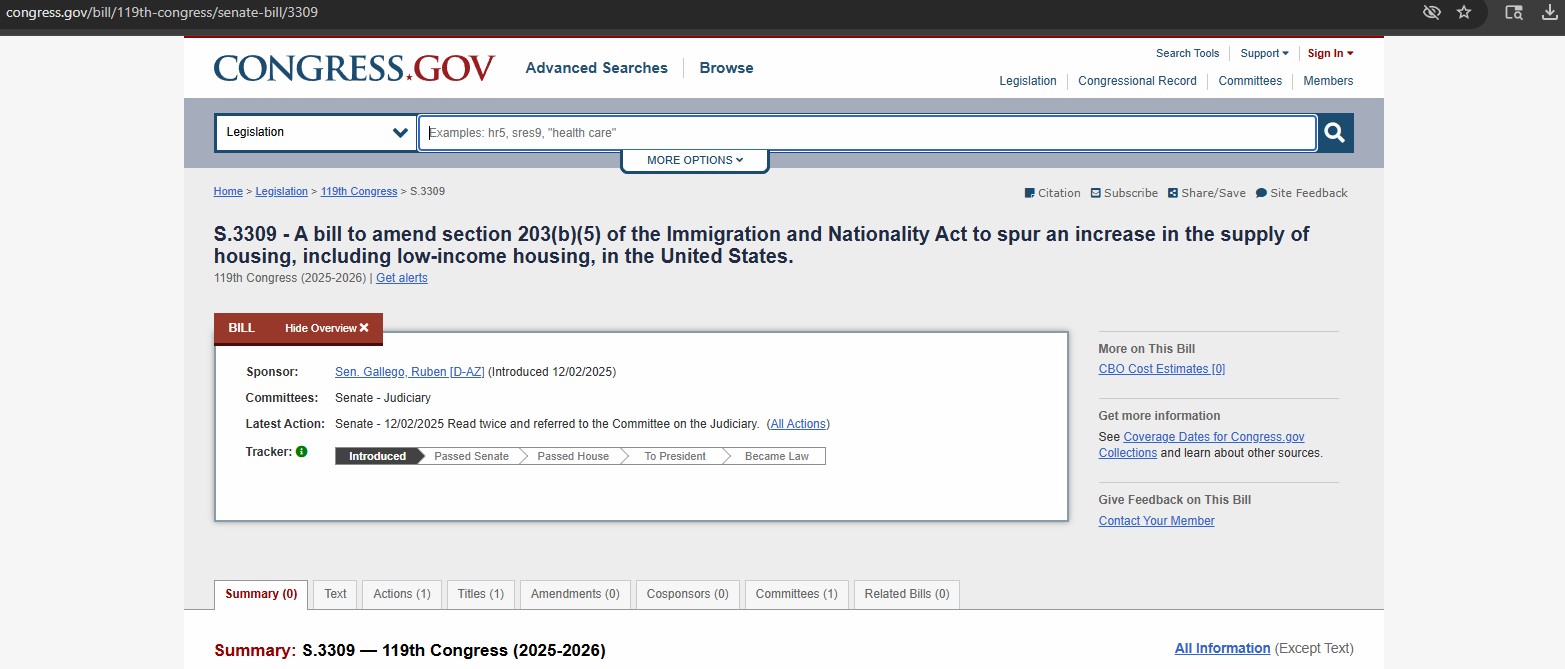Analysis of the IIUSA vs USCIS suit on EB-5 Sustainment Period (Part 1)
9th May, 2024
Read part 1 of our two-part analysis on IIUSA's sustainment lawsuit complaint regarding why we believe their logic is faulty, and what we plan to do to make sure EB-5 investors' rights are protected in the process.

Background: IIUSA, a regional center collective, has filed a lawsuit against USCIS challenging the two-year sustainment period rules that are currently applicable to post-RIA investors. As mentioned in our previous blog regarding this issue, AIIA is against this lawsuit as it will severely harm immigrants who invested after March 2022. We are now preparing our counter strategy to this suit in order to ensure investor’s voices are not lost in this process.
Based on discussions with our attorneys, we have solidified the most appropriate course of action to allow AIIA to participate in the IIUSA vs USCIS lawsuit. We believe that this fight over the sustainment period is crucial to protecting the rights of EB-5 investors and maintaining the integrity of the EB-5 program for current and future investors.
The legal proceedings will cost approximately $35,000, and we have launched a fundraiser for this effort. Our hope is to raise the money needed to fund our legal effort and put a stop to the entities seeking to profit from unnecessarily holding investors’ capital longer than required by the law.
In this series of articles we will break down the various arguments from the IIUSA complaint against USCIS on the sustainment period and our thoughts.
1. “USCIS Policy Didn’t Follow Proper Procedure”
In its complaint IIUSA argues that USCIS bypassed the proper legal channels by defining the sustainment period through a Q&A in October 2023 without the notice-and-comment rulemaking, which violated the Administrative Procedure Act (APA). IIUSA claims that a more formal rulemaking process should have been followed, allowing for public comment and industry involvement.
The IIUSA complaint bypasses the law, omitting to mention the fact that it was Congress who changed the language on sustainment. USCIS did not invent new sustainment period requirements in its 2023 Q&A. The EB-5 Reform and Integrity Act of 2022 (Pub. L. 117-103) changed the sustainment language in the law by amending INA 203(b)(5)(A)(i), INA 216A(b)(1)(B) and INA 216A(d)(1)(A). As the USCIS Q&A points out,
On March 15, 2022, President Biden signed the EB-5 Reform and Integrity Act of 2022 (RIA) as part of the Consolidated Appropriations Act. This statue reauthorized the Regional Center Program, enacted significant integrity reforms to the EB-5 Program, and, among other things, modified the requirements regarding the timeframe an investor must maintain their investment to establish eligibility for classification under INA 203(b)(5) and to subsequently remove the conditions on their lawful permanent resident (LPR) status under INA 216A. Specifically, INA 203(b)(5)(A)(i) states that, to be eligible for classification, the investment must be “expected to remain invested for not less than 2 years” while INA 216A, as amended by the RIA, no longer requires that the investor sustain their investment throughout their period of conditional residence.
The USCIS Q&A points out the APA’s notice-and-comment procedures do not apply when USCIS is only interpreting existing laws and rules, not creating new ones. USCIS cites a court case (Perez v. Mortgage Bankers Assoc.) to support this view. The USCIS Q&A is an interpretation and does not change the regulations or how they evaluate petitions. It holds that it is simply following the “plain language” of the law as closely as possible. We agree. The USCIS Q&A is not an abrupt change. Rather, it reflects changes to the Immigration and Nationality Act that were made by Congress in 2022 through the passage of the RIA, and the industry has known about this change since 2022 (see for example analysis by Robert Divine).
2. “USCIS’s action is contrary to the statute’s plain text and Congress’s intent”
IIUSA in their complaint states that “Given that Congress’s new statutory language is consistent with USCIS’s existing sustainment regulation, the most natural reading of the statute is that Congress intended to retain the existing calculation of the sustainment period, rather than silently jettison it. … If Congress had wanted a result inconsistent with binding regulation, it would have written a statute with a different, express result.”
Before the EB-5 Reform and Integrity Act of 2022 (RIA), the regulations included three mentions of a requirement to sustain EB-5 investment “throughout the period of the alien’s residence in the United States.” This language used to appear in INA 216.6(c)(1)(iii), INA 216A(b)(1)(B), and INA 216A(d)(1)(A). In RIA, Congress chose to strike out the sustainment language in INA 216A(b)(1)(B) and INA 216A(d)(1)(A), while also adding a new sustainment requirement in INA 203(b)(5)(A)(i), Why did Congress delete sustainment language in two of the three places it appears, and add new language, if Congress did not intend a change?
IIUSA says, in their complaint: “If, as USCIS’s new rule suggests, there is no independent need for an investor to sustain his or her investment longer than two years, there would be no need for redeployment at all. Congress’s new redeployment provisions would be superfluous in practice.”
Firstly, redeployment will still be needed for post RIA investors in the event that the project they invested in repays earlier than the two year minimum.
Furthermore, we can state for a fact that IIUSA and other regional centers pushed hard for the redeployment provisions to be added in the RIA, mainly because they had faced redeployment issues in the past with pre-RIA investors money. One could argue that this redeployment provision was mainly written for them (which we still believe to be highly unfair).
IIUSA goes on to say that “Congress added ‘specific visa set-asides for rural area projects, high unemployment area projects, and infrastructure projects,’ the latter of which is ‘limited to true public infrastructure projects–that is, those that benefit the public and the American people.’… As explained above, many of the types of projects Congress incentivized, including infrastructure projects and projects in urban, high unemployment areas (which tend to be large multifamily residences or commercial projects) usually rely on investments with a duration of five or more years, which further suggests that Congress did not intend to deviate from existing USCIS policy and longstanding practice when it adopted the RIA.
In a later part of their complaint they state “USCIS’s interpretation will also have perverse and destabilizing effects on the immigrant investor market. USCIS’s interpretation is additionally at odds with the RIA’s new incentives for infrastructure projects, which require longer hold periods on average.”
What’s a mystery to us when reading the arguments put forth by IIUSA is that it simply does not make sense. Investment issuers are more than capable of issuing investment offerings of varying lengths of investment timelines. If an EB-5 project requires 5 years to complete and repay its investors, it’s more than welcome to do so. The set-asides visas still incentivise investors for investing in projects that “benefit the public and the American people” as they allow for investors from backlogged countries to move ahead and grab a ‘reserved’ visa. In fact projects in rural areas not only have set aside visas but also benefit from priority processing, which regional centers have cheerfully advertised. Regional centers are not complaining about approval times for their rural petitions, which are being processed in less than a year–even when standard I-526 approval times on the USCIS website are listed at 54.5 months.
3. “USCIS’s actions are arbitrary and capricious (against regional centers)”
In their complaint, IIUSA states that “Here, USCIS provided almost no explanation for how it determined when the sustainment period should begin. It did not consider any alternatives or evaluate how best to harmonize the sustainment period with the other provisions of the statute, or the goals of the EB-5 program writ large.”
But USCIS did provide an explanation as to why this did not require a formal notice and comment period. The simple fact is that the agency plainly interpreted the law as written.
IIUSA further argues that “Incredibly, USCIS’s action does not even acknowledge that it departs from the existing USCIS regulation that has been in place for nearly 30 years. That alone renders the action arbitrary and capricious…”
IIUSA fails to acknowledge how exactly this rule is “capricious” to the organization or the board member regional centers. IIUSA fails to acknowledge that the RIA deleted the former provisions under INA 216A, which required USCIS to terminate an investor’s permanent residence IF they no longer “sustained the actions” required, meaning if they withdrew their capital before their conditional residence period ended. Moreover, USCIS is merely implementing the changes made by the RIA; the agency is not at fault for faithfully executing the law. Should IIUSA truly find the legislative language to be “arbitrary and capricious”, then it should argue its case in front of the Congress and not against USCIS.
IIUSA states that “In undermining this policy, USCIS immediately injured all who participate in the EB-5 program, including the regional centers that are IIUSA members. These entities will have fewer investors enroll in their projects, causing immediate economic harm. And the destabilizing effect of USCIS’s new rule will jeopardize current and prospective investment projects.”
Under a free market economy, substandard products will inherently attract fewer consumers. Should regional centers affiliated with IIUSA fail to find sufficient investors to subscribe to their projects, that would not be the fault of anyone but themselves. Conversely, if these regional centers created projects with favorable terms and solid sustainment protections, they would have no trouble expanding their clientele.
If IIUSA’s members pursue long-term projects and have greatly profited from redeploying investor’s money over and over again, benefiting from the delays of the agency and the invisible backlogs that have existed, it still does not make USCIS’s interpretation capricious and arbitrary.
IIUSA says: “Here, there are enormous investment-backed reliance interests premised on USCIS’s prior, longstanding regulation requiring investments to be sustained during an investor’s period of conditional residency. On the basis of these longstanding policies, investors have committed hundreds of millions of dollars to fund currently active projects across America that will ideally create significant jobs.”
Stating that there are interests that are dependent on a long sustainment period (essentially saying that regional centers do want to keep redeploying investor’s money) is a pernicious notion. To then state that investors have committed their hard earned money because of such interests is ridiculous. Naturally investors want to get their money back as soon as possible, not to be forced into redeployment even after satisfying the job creation requirement.
The IIUSA complaint drops the mask when it comes to redeployment. The IIUSA public statement on the lawsuit claims: “Importantly, the purpose of this lawsuit is not to return to the previous sustainment policy that required many EB-5 investors to redeploy their capital for extended periods.” However, the IIUSA complaint argues for bringing back to the previous sustainment policy that required many EB-5 investors to redeploy their capital for extended periods.
IIUSA says in its complaint that “Moreover, the agency’s action has the effect of undercutting other provisions of the RIA, rendering Congress’s new provisions governing redeployment, the additional third-year extension, and the RIA’s integrity provisions either irrelevant or unworkable in practice.”
Again, IIUSA’s lawsuit against USCIS’s policy guidance regarding the RIA’s change to the sustainment policy fails to consider several key points. First, redeployment is still necessary for some projects, such as those using bridge financing, where investors may have created sufficient jobs but have not met the two-year investment requirement. Second, the third-year extension in the RIA refers to a discretionary benefit that an investor must seek under INA 216A(c)(3)(B)(ii), rather than an automatic extension. The third-year extension is only necessary when an investor’s project has failed to create the minimum necessary jobs. And, additionally, the third-year extension requires “…that such alien’s capital will remain invested during such time.” This undermines IIUSA’s legal claim that a third-year extension of residence would affect sustainment – when the RIA specifically was updated to require sustainment during any third-year extension. Finally, USCIS retains its plenary power to conduct audits, monitor job creation, and ensure compliance by EB-5 projects, making IIUSA’s assertion about the agency’s irrelevance in maintaining program integrity nonsensical. These factors underscore the flaws in IIUSA’s position and highlight the importance of USCIS’s policy guidance in aligning the EB-5 program with the intent of the RIA.
Our article has only presented a portion of the faulty logic within IIUSA’s complaint, as there are simply too many flaws in its bad-faith reasoning.
Following discussions with legal counsel, we aim to participate in the critical IIUSA vs USCIS lawsuit. As we previously mentioned, getting investors’ voices heard is vital in this fight.
The lawsuit centers on the “sustainment period” – a key element impacting the rights and financial security of EB-5 investors. AIIA firmly believes a win for investors here is essential to safeguarding the program’s integrity for everyone involved, both current and future participants.
This legal battle comes at a cost – approximately $35,000. To ensure our voices are heard and protect investor interests, we have launched a fundraising campaign. Your contribution will directly challenge entities seeking to hold investor capital beyond legally mandated timeframes.
To support our work we encourage you to sign up for our email list, become a member, or make a donation of any amount to our organization.
Leave your comments
Responses (1)
Related Posts

We Congratulate Senator Gallego for New Legislation that Leverages the EB-5 Program to Build Affordable Housing

We Won The EB-5 Fee Increase Lawsuit

One Year Left to Invest in a EB-5 Regional Center Project

Trump Gold Card: A New Green Card Pathway Competing with EB-5

Stay Up To Date With AIIA
Join our newsletter to stay up to date on EB-5 updates.
By subscribing you agree to with our Privacy Policy and provide consent to receive updates from our company.
Recommended Resources

How to find a good EB-5 Litigation Attorney
Choose an attorney with EB-5 and litigation experience who is organized, detail-oriented, and avoids making guarantees. You may need a...
Read More
The Sale of EB-5 Securities Offerings
EB-5 securities sales often use Regulation D (U.S. investors) and Regulation S (foreign investors) exemptions to avoid SEC registration while...
Read More
Choosing between Direct vs Regional Center EB-5 financing
Direct EB-5 suits single investors creating direct jobs; Regional Center EB-5 pools multiple investors, counting direct and indirect jobs for...
Read MoreRecent Blog Posts

We Congratulate Senator Gallego for New Legislation that Leverages the EB-5 Program to Build Affordable Housing
Sen. Gallego's EB-5 bill mobilizes foreign capital to build affordable housing. This collaboration has boosted AIIA's Congressional ties & credibility...
Learn More
We Won The EB-5 Fee Increase Lawsuit
AIIA successfully won its lawsuit against USCIS’s April 2024 EB-5 fee increases, with a federal judge ruling that the agency...
Learn More
One Year Left to Invest in a EB-5 Regional Center Project
AIIA warns that EB-5 Regional Center investors will lose protection after Sept. 30, 2026 unless they file I-526E petitions before...
Learn More
Trump Gold Card: A New Green Card Pathway Competing with EB-5
Trump’s new $1M “Gold Card” visa plan competes directly with EB-5 and raises serious legal concerns, as it lacks statutory...
Learn MoreGet In Touch With Us
If you have any questions, inquiries, or collaboration proposals, please don’t hesitate to reach out to us.

Well written. I hope they don’t win this lawsuit